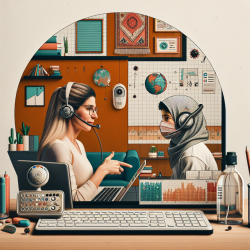Introduction
The COVID-19 pandemic has highlighted numerous challenges faced by visually impaired students in Bangladesh, particularly in accessing education through digital means. A preliminary study conducted by Mahfuz, Sakib, and Husain (2021) sheds light on these challenges and offers valuable insights for practitioners providing online therapy services to schools. By understanding and implementing the outcomes of this research, practitioners can improve their skills and create better educational outcomes for visually impaired students.
Key Findings from the Study
The study employed a mixed-methods approach, involving both quantitative surveys and qualitative interviews with visually impaired students in Bangladesh. The findings reveal significant barriers to accessing Information and Communication Technology (ICT) resources, which are crucial for educational success.
- Limited Access to Technology: Many visually impaired students lack access to basic technology, such as screen readers and Braille displays, which are essential for their learning.
- Inadequate Training: Students often do not receive adequate training in using available technology, which hampers their ability to participate fully in online education.
- Dependency on Volunteers: Due to the lack of accessible resources, students frequently rely on volunteers for tasks such as note-taking and accessing study materials.
- Challenges in Online Learning: The shift to online education during the pandemic has exacerbated these issues, with many students struggling to access digital content and participate in virtual classes.
Recommendations for Practitioners
To enhance online therapy services for visually impaired students, practitioners can implement the following strategies based on the study's recommendations:
- Provide Comprehensive ICT Training: Ensure that visually impaired students receive thorough training in using available technology, including screen readers and other assistive devices.
- Enhance Accessibility: Advocate for the development and distribution of accessible digital resources, such as Braille books and audio materials, to support students' learning.
- Facilitate Volunteer Support: Establish programs to recruit and train volunteers who can assist visually impaired students with tasks like note-taking and accessing study materials.
- Promote Inclusive Education: Work with educational institutions to create inclusive policies and practices that accommodate the needs of visually impaired students in both online and in-person settings.
Encouraging Further Research
While the preliminary study provides valuable insights, there is a need for further research to explore the long-term impacts of these challenges and the effectiveness of proposed solutions. Practitioners are encouraged to engage in collaborative research efforts to develop innovative strategies for supporting visually impaired students in the digital age.
Conclusion
By understanding the challenges faced by visually impaired students and implementing data-driven strategies, practitioners can enhance online therapy services and contribute to more equitable educational outcomes. This research serves as a call to action for educators, policymakers, and researchers to work together in creating a more inclusive and accessible educational environment for all students.
To read the original research paper, please follow this link: A preliminary study on visually impaired students in Bangladesh during the COVID-19 pandemic.










